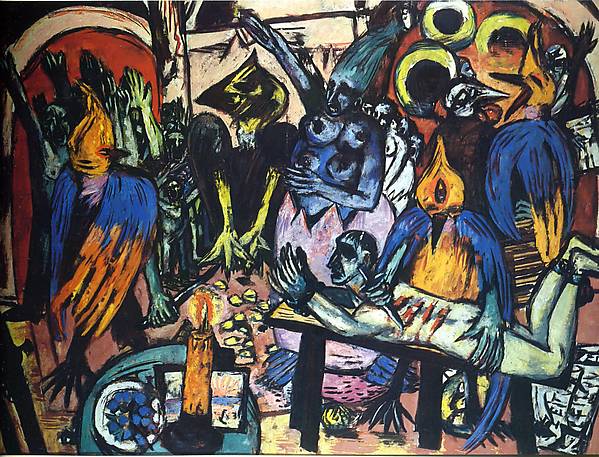Contributed by Laurie Fendrich / “Modern Art and Politics in Germany 1910-1945” an exhibition of more than 70 paintings and sculptures on loan from the Neue Nationalgalerie, Berlin to the Kimbell Museum in Fort Worth, runs on three tracks. The first carries the art, two-thirds of which has never before been seen in the United States. The second, via informative and well-written wall texts, follows political developments in Germany during three-and-a-half fraught decades. The third consists of the imaginations of museumgoers who, like me, can’t help but see similarities between Weimar Germany in the years leading up to Hitler’s rule and America during Trump’s rise and authoritarian presidency.
Tag: Max Beckmann
Yura Adams: A freewheeling conversation with Daniel Giordano
Daniel Giordano: Yura, I want to play a game of me spitting out a question and you rattling off an answer. A real Martin Kippenberger special of a “first thought, best thought” type response to keep us on our toes… Okay, so here we go: What artists do you steal from most and what bag of tricks did you whip out to aid in the making of your installation at Olympia?
Dannielle Hodson’s infectious imagination
Contributed by Margaret McCann / “Chasing Rabbits,” the name of Danielle Hodson’s show at Kravets Wehby Gallery, refers to the cautionary Chinese proverb, “if you chase two rabbits, both will escape.” Hodson accepts that risk, bypassing clear purpose to embrace multiplicity. Impelled by curiosity – as Alice was, and Grace Slick advised – Hodson’s visual gestalts, though far livelier than Cezanne’s, similarly invite the viewer to re-experience their becoming…
Elizabeth Flood’s numb sublime
Contributed by Margaret McCann / Elizabeth Flood’s landscapes in “Lookout” at Storage Gallery included oil paintings that emphasize realism and expressionistic ink drawings. The latter express vigorous engagement with the outdoors. Gettysburg (Pickett’s Charge, October 9) channels the drama of that day. Stirring energy like that of George Nick’s alla prima work drives the eye deep into a field under a sensational sky. Conversely, mental distance accompanies Flood’s large polyptychs, whose combinations resemble photographic contact sheets, art website layouts, or bulletin board accruals. At their best, artifice is imbued with the existential doubt of Edwin Dickinson or Giacometti. Repetition and variance become metaphors for modern contingency and ambivalence. Multiple views rouse a mix of ennui, curiosity, taste, and choice, like that fueling our daily shuffle through cyberspace.
Nancy Powhida: At home in another world
Contributed by Jonathan Stevenson / Nancy Powhida, age 80, has just had her first solo exhibition in New York, curated by Kristen Jensen at Essex Flowers. Titled a deceptively straightforward “Oh Dear! Our Life was Like a Horror Show! (No Wonder You Had to Learn to be Resourceful),” the show comprised six graphite drawings and one oil painting, each piece an unnervingly moving revelation.
Neue Galerie’s “degenerate” art and Babylon Berlin
Contributed by Jonathan Stevenson / Neue Galerie?s compellingly incisive exhibition, titled ?Eclipse of the Sun: Art of the Weimar Republic? and anchored by Georg Grosz?s […]
Artists under duress: Max Beckmann
Contributed by Jonathan Stevenson / Esteemed in Germany during the Weimar Republic but branded a “degenerate artist” by the anti-modern Adolf Hitler, the great expressionist […]
Studio pin-ups from Germany
The little pictures and postcards that artists hang on our studio walls create a visual guide to our artistic DNA. Over in the corner, or […]
Dallas: David Bates paints Katrina’s victims
David Granberry at the Dallas Morning News writes about David Bates, whose recent paintings presented at Dunn and Brown Contemporary depict the victims of Hurricane […]
German history paintings: Dix, Grosz, Beckmann, Meidner and Steinhardt
“Allemagne, les Ann�es Noires,” or “Germany: The Black Years,” organized by Annette Vogel and Bertrand Lorquin. Mus�e Maillol, Paris. Through Feb. 4. In the NYTimes, […]



























